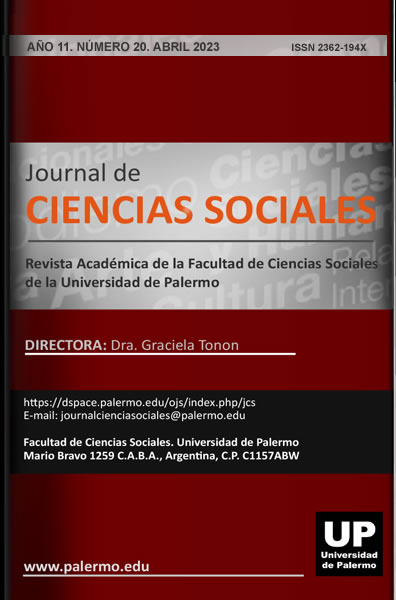Social networks as a communication system in the universities of AMBA, Argentina
Abstract
In the 20th century, the mass media of social communication were installed as instances that favored social debates and contributed to a process of broadening citizen participation in the public sphere. The Internet and the cheapening of digital devices turned the old audiences into users. Web 2.0 differed from its predecessor (known as 1.0) by a fundamental feature: collaborative participation. In mass societies, the media are available as an indispensable tool for both constituted and de facto powers to reach citizens, becoming the "agora" of the end of modernity. In this context, access to communicative resources that allow the production of meanings is essential in complex power relations. For their part, the spaces of resistance, with the same logic, need the construction of alternative discourses that promote a new meaning. The new media map, in which social networks stand out, demands a new definition of citizen participation. The objective of this work is to present a proposal for the analysis of the activity in social networks of the national universities of the Metropolitan Area of Buenos Aires (AMBA), Argentine Republic.
Downloads
References
Alonso, G. y Arébalos, A. (2011). La revolución horizontal. Ediciones B.
Andrade del Cid, P. (2009). La democracia en el espacio público mediático. Global Media Journal, 6(12), 91-100.
Castells, M. (2009). Comunicación y Poder. Alianza.
Claverie, J. (2013). La universidad como organización: tres enfoques para el análisis de sus problemas de gestión. Gestión y Gerencia, 7(1), 4-27.
Cristti, N. y Naón, G. (2018). La comunicación institucional de los Gobiernos Municipales a través de las redes sociales. El caso de Lomas de Zamora, Esteban Echeverría y Almirante Brown. Hologramática, 1(27), 132-150. www.cienciared.com.ar/ra/usr/3/1749/holo27_vol1_132_150.pdf
De Moraes, D. (2013). Medios, poder y contrapoder. Biblos.
Del Mazo, G. (1941). La Reforma Universitaria Tomo I. Edición del Centro de Estudiantes de Ingeniería. http://libros.unlp.edu.ar/index.php/unlp/catalog/view/439/405/1461-1.
Eco, U. (1984). Apocalípticos e Integrados. Lumen.
Elizalde, L. (2009). Gestión de la comunicación pública. Bosch.
Elizalde, L. y Riorda, M. (2013). Comunicación Gubernamental 360. La Crujía.
Geertz, C. (1987). La interpretación de las culturas. Gedisa.
Guzmán Duque, A. P., del Moral Pérez, M. E., González Ladrón de Guevara, F. y Gil Gómez, H. (2013). Impacto de Twitter en la comunicación y promoción institucional de las universidades..Pixel-Bit. Revista de Medios y Educación, (43),139-153.
Habermas, J. (1981). Historia y crítica de la opinión pública. Ed. Gili.
Hall, R. H. (1996). Organizaciones: Estructuras, procesos y resultados. Prentice Hall Hispanoamericana
Islas, O. (2010). Internet 2.0: El territorio digital de los prosumidores, Revista de Estudios Culturales, 3(5), 43-63.
Kirkpatrick, D. (2011). El efecto Facebook. Editorial Gestión 2000.
Mintzberg, H. (2005). La estructuración de las organizaciones. Ed. Ariel Economía.
Luhmann, N. (1998). Organización y decisión. Herder.
Orihuela, J. L. (2011). Mundo Twitter. Ed. Alienta.
Vacas, F. (2010). La Comunicación Vertical. Ed. La Crujía.
Vera de Flachs, M. C. (2006). Notas para la historia de la Universidad en Argentina. Revista Historia de la Educación Latinoamericana, 8, 65-112.
Otros documentos consultados
Honorable Congreso de la Nación Argentina. Ley nacional N° 24.521/1995, Ley de Educación Superior (1995). Boletín Oficial Nº 28.204
Sistema de Información Cultural de la Argentina. Ministerio de Cultura de la Nación (SINCA). (2017). Resultados de la Encuesta Nacional de Consumos Culturales. Recuperado de: https://datos.cultura.gob.ar/dataset/encuesta-nacional-de-consumos-culturales-2017/archivo/9a97dde5-3a33-4689-8333-24a2fa5b4a6e
The authors retain the rights to their work guaranteeing this journal the right of first publication, committing to cite the Journal of Social Sciences as a reference of the original publication.
The works published in the Journal are published under the terms indicated in the Creative Commons License with the International Attribution 4.0 (CC BY 4.0).




























